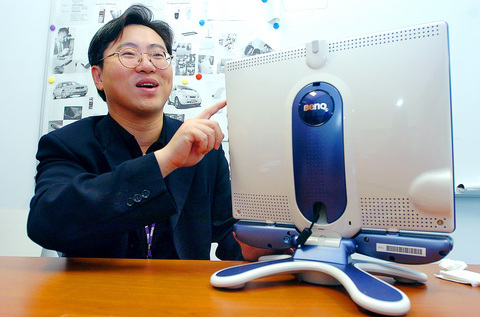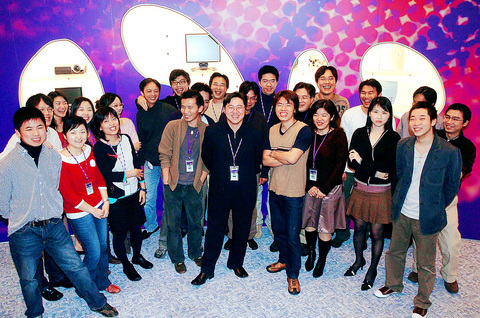How does a company get out of the quagmire of the free-fall in gross margins that have long plagued Taiwanese electronics makers? Build a brand. That is what Taiwanese consumer-electronics maker BenQ Corp (明基電通) opted for three years ago.
Taking a road rarely travelled by most Taiwanese companies, BenQ's expansion into own-brand business has converted a former skeptic.

PHOTO: GEORGE TSORNG, TAIPEI TIMES
"It is the biggest adventure I've ever had in my life [to join the stable of world-class brands]. ...Now we are feeling more comfortable about it [the decision]," BenQ chairman Lee Kun-yao (李焜耀) said recently.

PHOTO: GEORGE TSORNG, TAIPEI TIMES
Most Taiwanese electronics manufacturers still stick to making products for international computer hardware vendors such as Dell Inc and Hewlett-Packard Co. Over 70 percent of the world's laptop computers are made by Taiwanese manufacturers, but few of them carry local names.
BenQ is one of them. In just a few years, BenQ has emerged as an up-and-coming brand both at home and abroad. The purple butterfly-shaped corporate logo is mushrooming from its home turf to Europe.
Powerful Chinese brands, by contrast, have a low brand awareness outside the country, despite companies' aggressive moves to expand overseas by acquiring multinationals. The latest case in point is Lenovo Group Ltd's (
BenQ will not consider using this strategy to boost its overseas market position, Lee said, as the Taiwanese company has already made significant progress in foreign markets, especially in Europe.
A quarter of BenQ's total sales was recorded in the European market, where people favor trendy products, the company said.
Own-brand business made up around 40 percent of BenQ's total sales in the current quarter and is expected to exceed that ratio next year, well ahead of the aim to boost brand-name operations to account for half of the sales in 2008, Lee said.
The remaining 60 percent came from OEM (original equipment manufacturing) business. BenQ makes mobile phones for the world's top cellphone vendor Nokia Oyj and makes LCD monitors for Dell Inc.
With the increasing contribution from its own-brand operations, BenQ secured a gross margin of 11 percent in the third quarter, while Compal Electronics Inc (仁寶電腦), the world's second-largest notebook computer contract maker, struggled to sustain the margin at 5 percent.
A frequent question is how BenQ, a new brand from Taiwan, diverted consumers' eyes from established players in just three years?
"BenQ is quite right in its brand strategy. Take a look at its faster-than-expected brand expansion and you'll find it did work," said Steven Tseng (
Talking about BenQ's brand positioning, Lee said "we hope to bring enjoyment to our customers through our products."
The clear brand strategy saved BenQ half the time its local predecessors such as Acer Inc needed to boost brand awareness, Tseng said.
But, novel industrial design has been key to establishing the brand concept in BenQ's electronic devices, from digital music players to liquid-crystal-display (LCD) televisions, Tseng said.
"BenQ is gradually cultivating a cult following among its users, like Apple Computer Inc did with its popular iMacs and iPods. This is the highest goal a brand can achieve," Tseng said.
Lifestyle design was BenQ's core competitiveness area when the brand started out in 2001, Lee said.
"People were suspicious of this strategy. But, now we see followers taking the same steps as BenQ," Lee said.
Two years ago, Asustek Computer Inc (華碩電腦), the world's largest motherboard maker, established a design center for its branded computers under the "ASUS" brand.
However, no significant progress was made until recently, when Asustek tapped into the consumer electronics market with its first mobile phone hitting local stores early this year.
Even before Asustek, BenQ set up its Lifestyle Design Center in 2001 to blend the brand's core value, "enjoy technology," with customers' anticipation for new electronic gadgets.
The center's location reflects its importance.
Situated on the 13th floor of BenQ's 14-storey office building in Taipei's Neihu district, the center has specially-designed stairs spiraling up directly to the company's core management on the top floor.
Explaining BenQ's product-design concept, the center's director Manfred Wang (王千睿) said that "product design is extremely important for us to differentiate between BenQ's existing brands and IT (information technology) brands. BenQ is a consumer-electronics brand."
BenQ sent its designers overseas to research how the target market lives and what their expectations were of new electronics, the 38-year-old Wang said.
"Design is not merely about the look of a product. But, aesthetics should not overrule functionality," he said.
Here is an example: BenQ's FP783 LCD monitor, on the cover of Business Weekly's July 5 issue, is equipped with graceful creamy butterfly-wing speakers and a purple base station, which can be folded away to make it more mobile.
The design team's work has received a positive response. The team, consisting of a mere 70 designers -- about one-seventh of the 470-strong team of South Korean electronics giant Samsung Electronics Co -- has notched up 58 international product-design awards in the past three years.
In the 10 years since Samsung set up its lifestyle design laboratory, the South Korean consumer-electronics maker has won only 100 similar awards with a larger design team, Wang said.
BenQ plans to expand its design center team to around 100 next year by increasing its members in Taipei and establishing a Chinese design center in Suzhou. The aim is for the team to increase to 200 by 2006, Wang said.
Rapid growth in own-brand sales has impressed investors and prompted worldwide attention, but it may be too early to say whether BenQ will succeed in becoming a power brand like Samsung, analysts said.
A conflict between own-brand operation and OEM business is the biggest challenge before the young brand can rely on brand-name products to make profits, Yuanta Core Pacific's Tseng said.
A slim portion of the company's earnings now come from own-brand operations, BenQ chief financial executive Eric Yu (
BenQ's shrinking handset OEM business is a case in point, Tseng said. Motorola Inc, which used to be BenQ's biggest client, recently switched its OEM partnership to another local mobile phone maker, Compal Communications Inc (華寶通訊).
That happened to coincide with BenQ's fast expansion in the branded mobile-phone area in Taiwan as well as emergent markets, he said.
Looking at BenQ's bottom line, analysts note that half of an estimated NT$8.23 billion in earnings come from its liquid-crystal-display (LCD) affiliate AU Optronics Corp (友達光電) rather than the core business.
Heavy marketing expenditure, which is seen as the norm for companies to boost brand awareness, is also a concern.
"BenQ skimps on brand marketing. But we also fear that drastic increases in spending could be a burden," said Vincent Chen (
BenQ has in the past years spent about 6 percent of its total annual sales to market branded electronics, according to BenQ's Yu. The percentage is well below the 10 percent Samsung spends every year.
"Running a brand is a long-term effort. It is hard to judge now whether BenQ will succeed, but BenQ has already caught the world's attention," Chen said.

CHIP WAR: Tariffs on Taiwanese chips would prompt companies to move their factories, but not necessarily to the US, unleashing a ‘global cross-sector tariff war’ US President Donald Trump would “shoot himself in the foot” if he follows through on his recent pledge to impose higher tariffs on Taiwanese and other foreign semiconductors entering the US, analysts said. Trump’s plans to raise tariffs on chips manufactured in Taiwan to as high as 100 percent would backfire, macroeconomist Henry Wu (吳嘉隆) said. He would “shoot himself in the foot,” Wu said on Saturday, as such economic measures would lead Taiwanese chip suppliers to pass on additional costs to their US clients and consumers, and ultimately cause another wave of inflation. Trump has claimed that Taiwan took up to

A start-up in Mexico is trying to help get a handle on one coastal city’s plastic waste problem by converting it into gasoline, diesel and other fuels. With less than 10 percent of the world’s plastics being recycled, Petgas’ idea is that rather than letting discarded plastic become waste, it can become productive again as fuel. Petgas developed a machine in the port city of Boca del Rio that uses pyrolysis, a thermodynamic process that heats plastics in the absence of oxygen, breaking it down to produce gasoline, diesel, kerosene, paraffin and coke. Petgas chief technology officer Carlos Parraguirre Diaz said that in

Japan intends to closely monitor the impact on its currency of US President Donald Trump’s new tariffs and is worried about the international fallout from the trade imposts, Japanese Minister of Finance Katsunobu Kato said. “We need to carefully see how the exchange rate and other factors will be affected and what form US monetary policy will take in the future,” Kato said yesterday in an interview with Fuji Television. Japan is very concerned about how the tariffs might impact the global economy, he added. Kato spoke as nations and firms brace for potential repercussions after Trump unleashed the first salvo of

SUPPORT: The government said it would help firms deal with supply disruptions, after Trump signed orders imposing tariffs of 25 percent on imports from Canada and Mexico The government pledged to help companies with operations in Mexico, such as iPhone assembler Hon Hai Precision Industry Co (鴻海精密), also known as Foxconn Technology Group (富士康科技集團), shift production lines and investment if needed to deal with higher US tariffs. The Ministry of Economic Affairs yesterday announced measures to help local firms cope with the US tariff increases on Canada, Mexico, China and other potential areas. The ministry said that it would establish an investment and trade service center in the US to help Taiwanese firms assess the investment environment in different US states, plan supply chain relocation strategies and